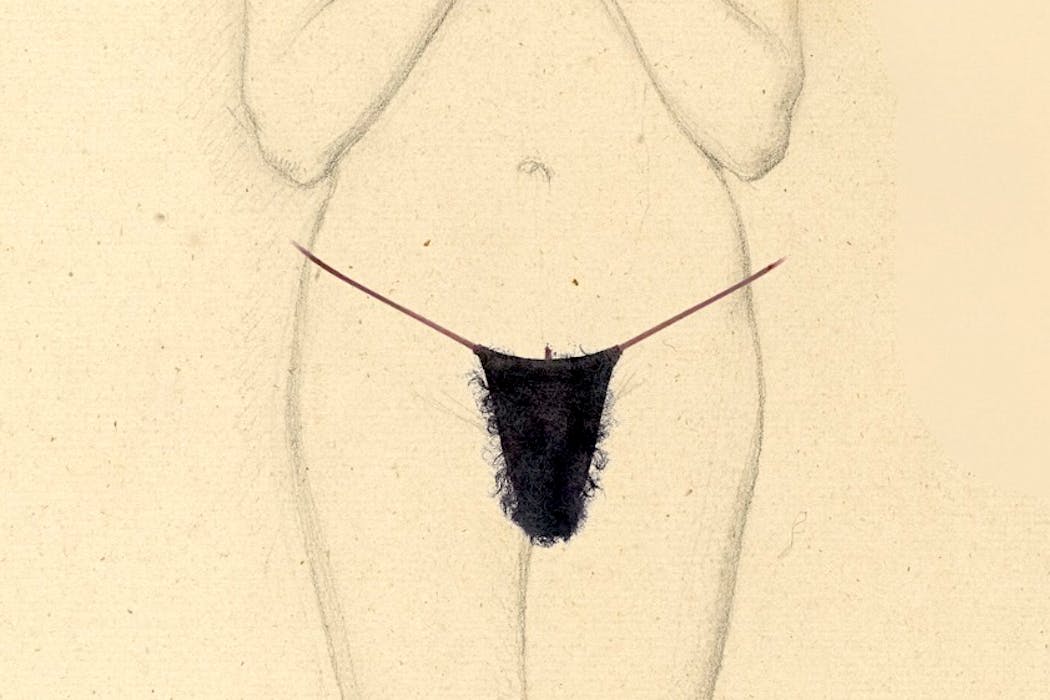Skims has put merkins back on the fashion map. Here’s a brief (and hairy) history of the pubic wig
- Written by Esmé Louise James, Doctor of Philosophy, The University of Melbourne

Kim Kardashian’s clothing brand, Skims, has been no stranger to a controversial campaign. Over the past few years, Skims has repeatedly made headlines for releasing divisive products such as the nipple bra and hip-enhancing shorts.
Its latest release is no exception. Last week, the brand announced the release of an A$70 faux hair micro thong, available in twelve different colour and hair texture variations. The product has rightly been identified as a merkin – a pubic wig, or hairpiece for the pubic area.
While this controversial thong has been released as part of a 1970s-themed campaign, the history of the merkin dates much further back.
Venereal disease
The merkin is believed to have originated in the Early Modern period in Europe. The Oxford Companion to the Body dates its debut to 1450, though its exact origin remains contested.
What is known for certain, however, is the function of this curious piece of clothing. By the end of the 15th century, a major syphilis epidemic had swept Europe. The initial outbreak became known as the “Great Pox”. It led to widespread death and disfigurement, before becoming less virulent in later centuries.
As historian Jon Arrizabalaga and colleagues explain:
In some cases, the lips, nose or eyes were eaten away, or on others the whole of the sexual organs.
Pubic wigs became a practical way to conceal signs of the disease around the genital area. As well as hiding syphilitic sores, merkins could help to mask the scent of rotting flesh by adding a lavender-scented powder to the material.
It has been estimated that by the 18th century, one in five Londoners suffered from syphilitic infection. Admission records of London’s hospitals and workhouse infirmaries show syphilis was particularly rife among young, impoverished and mostly unmarried women, who used commercial sex to support themselves.
With no effective cure for the disease found until the beginning of the 20th century, it is hardly surprising merkins were used to conceal undesirable symptoms.
Pubic lice
Pubic wigs also proved useful for preventing the spread of pubic lice. England and France were battling rampant infestations of lice well into the 17th century. Shaving one’s pubic hair was, understandably, a proven method to prevent infestation.
However, this hairless appearance carried a negative stigma, as it was associated with the presence of disease and prolific engagement with vice.
Pubic wigs offered a solution to this perverse beauty paradox of the time, allowing women to appear unshaven (thus, healthy and clean) while being shaven to prevent infestation and spread of lice. The wigs could be boiled or even baked after use to assure sterilisation.
Appearances in literature
Although cultural awareness clearly predates it, the first recorded use of the term “merkin” comes from John Taylor’s Observations and Travel, published in 1617. It features among a satirical list of exotic and indulgent imports – such as “apes, monkeys, merkins, marmosets” – suggesting it was already recognised as a risqué commodity associated with vanity and excess.
The merkin continued to appear across a wide range of literature from the 17th century, particularly in bawdy pieces of work, such as the following 1661 poem:
He laid her on the ground,His Spirits fell a ferking,Her Zeal was in a sound,He edified her Merkin.
Its use is most commonly associated with sex workers, though it is plausible wealthy individuals would also have adorned themselves with merkins to preserve the appearance of beauty and health.
Powdered wigs were adopted by nobility in the 18th century to conceal hair loss and deformities that resulted from syphilis, so it is not a stretch to imagine merkins would have been adopted as well.
By 1786, the term “merkin” had entered the formal lexicon, defined in Francis Grose’s A Classical Dictionary of the Vulgar Tongue as “counterfeit hair for women’s privy parts”.
Merkins today
As public health improved and societal attitudes towards hygiene changed, merkins largely fell out of fashion.
By the late 19th century, they had mostly faded into obscurity and survived only as a quirky historical footnote. One example is the well-known faux-Victorian photograph of a supposed merkin salesman peddling his display case of pubic wigs, which is circulating as though it were a genuine 19th century image.
While the Skims micro thong may appear to be a cheeky novelty, the merkin itself boasts a centuries-long history – evolving from a practical accessory to a provocative fashion statement today.
The Skims line of “full bush” thongs were quickly sold out soon after they were announced. While the company hasn’t made the intention behind the product clear, its virality has certainly sparked a broader conversation about body hair politics.
In many ways, even these cultural conversations mirror those from centuries prior. The merkin’s very existence is proof that women’s body hair has, for hundreds of years, doubled as a potent symbol of health, sexuality, fashion and autonomy.
Authors: Esmé Louise James, Doctor of Philosophy, The University of Melbourne


















